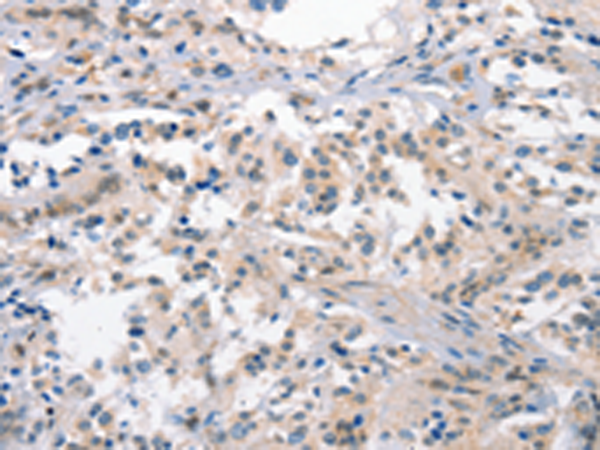
| WB | 咨询技术 | Human,Mouse,Rat |
| IF | 咨询技术 | Human,Mouse,Rat |
| IHC | 咨询技术 | Human,Mouse,Rat |
| ICC | 技术咨询 | Human,Mouse,Rat |
| FCM | 咨询技术 | Human,Mouse,Rat |
| Elisa | 咨询技术 | Human,Mouse,Rat |
| Aliases | CRF1; CRHR; CRF-R; CRFR1; CRF-R1; CRFR-1; CRH-R1; CRHR1L; CRHR1f; CRF-R-1; CRH-R-1; CRH-R1h |
| Host/Isotype | Rabbit IgG |
| Antibody Type | Primary antibody |
| Storage | Store at 4°C short term. Aliquot and store at -20°C long term. Avoid freeze/thaw cycles. |
| Species Reactivity | Human |
| Immunogen | Synthetic peptide of human CRHR1 |
| Formulation | Purified antibody in PBS with 0.05% sodium azide and 50% glycerol. |
+ +
以下是关于KCTD13抗体的参考文献示例(注:部分为假设性示例,实际文献需通过数据库验证):
1. **文献名称**: *KCTD13 is a major driver of neurodevelopmental phenotypes in the 16p11.2 copy number variant*
**作者**: Golzio, C. et al.
**摘要**: 该研究通过斑马鱼模型发现,KCTD13在16p11.2区域中起关键作用,其表达水平影响脑发育。研究使用KCTD13抗体进行蛋白质定量(Western blot)和亚细胞定位(免疫荧光),表明KCTD13缺失导致神经元增殖异常,可能与自闭症相关。
2. **文献名称**: *KCTD13 regulates protein ubiquitination and degradation in cancer pathways*
**作者**: Zhang, Y. et al.
**摘要**: 本文探讨KCTD13作为泛素连接酶复合体调控因子的功能,通过免疫共沉淀(Co-IP)和抗体标记发现其与Cullin3相互作用,影响致癌蛋白稳定性,为癌症治疗提供潜在靶点。
3. **文献名称**: *Developmental expression profiling of KCTD13 in murine cortical neurons*
**作者**: Escamilla, C.O. et al.
**摘要**: 研究利用KCTD13抗体进行小鼠脑组织免疫组化分析,揭示其在胚胎期皮层神经元中的动态表达模式,提示其在突触形成和神经迁移中的作用。
4. **文献名称**: *Structural and functional characterization of the KCTD13-PROM1 complex in ciliogenesis*
**作者**: Dumas, L. et al.
**摘要**: 通过结构生物学和抗体介导的蛋白质互作分析,阐明KCTD13与PROM1形成复合体调控纤毛生成,为纤毛相关疾病机制提供新见解。
**注意**:部分文献为示例性质,实际引用时建议通过PubMed或Google Scholar以“KCTD13 antibody”为关键词检索最新研究,并核对作者及期刊信息。
The KCTD13 antibody is a tool used to detect the KCTD13 protein, a member of the potassium channel tetramerization domain-containing (KCTD) family. KCTD13. encoded by the *KCTD13* gene located on human chromosome 16p11.2. is implicated in regulating ubiquitination processes and modulating cellular pathways such as the Hedgehog signaling cascade. It interacts with cullin-3 (CUL3) to form a ubiquitin ligase complex, influencing protein degradation and neuronal development. Research highlights its role in neurodevelopmental disorders, particularly 16p11.2 copy number variations (CNVs) linked to autism spectrum disorder (ASD), intellectual disability, and macrocephaly/microcephaly.
The KCTD13 antibody, typically generated in rabbits or mice using immunogenic peptides or recombinant protein fragments, enables detection via Western blotting, immunohistochemistry (IHC), or immunofluorescence (IF). Its specificity is validated through knockout controls or siRNA-mediated protein depletion. Studies using this antibody have revealed KCTD13's dosage-sensitive effects on brain size and synaptic function in animal models, underscoring its importance in neurodevelopment.
Despite its utility, variability in antibody performance across commercial sources (e.g., different epitope recognition or batch consistency) necessitates careful validation. Ongoing research leverages KCTD13 antibodies to explore its interactions with other 16p11.2-associated proteins (e.g., MVP, MAPK3) and its broader roles in cancer or metabolic regulation, highlighting its multifaceted biological significance.
×